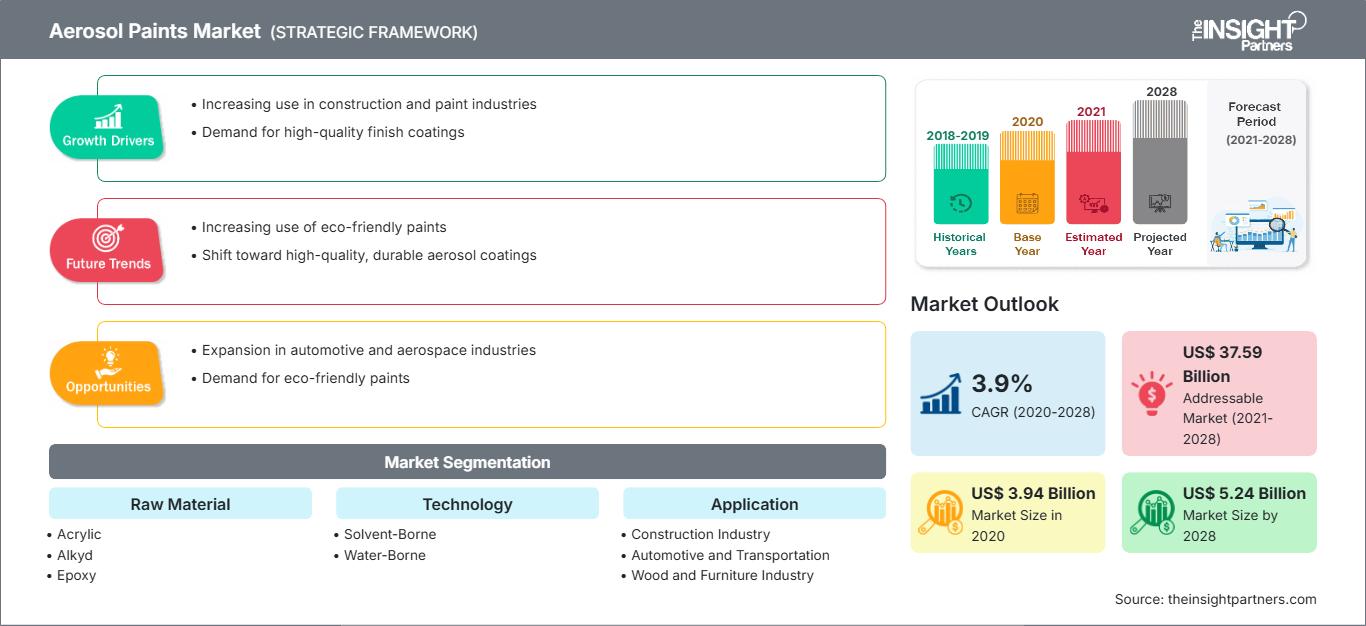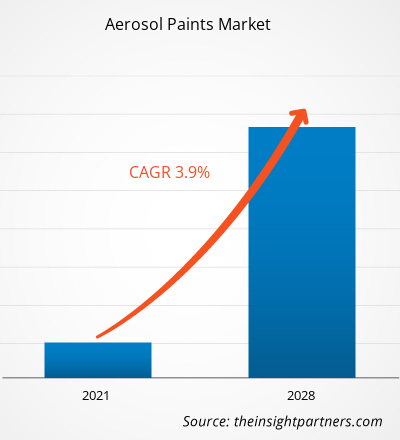[Forschungsbericht]Der globale Markt für Sprühfarben wurde im Jahr 2020 auf 3.941,90 Millionen US-Dollar geschätzt und soll bis 2028 5.238,49 Millionen US-Dollar erreichen; von 2021 bis 2028 wird ein CAGR-Wachstum von 3,9 % erwartet.
Sprühfarben sind in versiegelten Druckbehältern erhältlich. Sie sind in verschiedenen Farben und Ausführungen verfügbar und daher bei Verbrauchern beliebt. Sie werden häufig im Bau- und Automobilsektor verwendet, da sie einfach anzuwenden sind und schnell trocknen.
Im Jahr 2020 hatte der asiatisch-pazifische Raum den größten Anteil am globalen Markt für Sprühfarben. Es wird auch geschätzt, dass dieser Raum im Prognosezeitraum die schnellste CAGR des Marktes verzeichnen wird. Die Nachfrage nach Sprühfarben wird in der Region aufgrund verschiedener Faktoren wie der enormen Bevölkerungsbasis, des steigenden verfügbaren Einkommens und des verbesserten Lebensstandards voraussichtlich steigen. Das Wachstum des Marktes für Autoreparaturlacke hat ebenfalls positiv zum Anstieg der Nachfrage nach Sprühfarben im asiatisch-pazifischen Raum beigetragen. Diese Faktoren haben auch ausländische Unternehmen dazu bewogen, in die Region zu expandieren. Darüber hinaus ist das schnelle Wachstum dieser Region auch auf das Wachstum der dortigen Bauindustrie zurückzuführen. China ist der weltgrößte Baumarkt und dürfte in den nächsten Jahren deutlich wachsen. Auch andere Schwellenländer wie Indien werden voraussichtlich enorm wachsen, da der Schwerpunkt der Region auf der Ankurbelung der inländischen Produktionsaktivitäten liegt.
Der Ausbruch von COVID-19 wurde als Pandemie betrachtet und hat zahlreiche Unternehmen weltweit schwer getroffen. Die Pandemie hatte die stärksten Auswirkungen auf die Produktions-, Logistik- sowie Tourismus- und Reisebranche. Der Virusausbruch veranlasste die Regierungen zahlreicher Länder, einen Lockdown zu verhängen, um die Ausbreitung des Virus einzudämmen. Daher kommt es in mehreren Unternehmen zu Ausfallzeiten, und einige Unternehmen arbeiten derzeit im Homeoffice, was zu geringerer Produktivität und geringeren Einnahmen führt. Die Chemie- und Werkstoffindustrie ist einer der wichtigsten Sektoren, die aufgrund dieses Ausbruchs unter schweren Störungen wie Lieferkettenunterbrechungen, Absagen von Technologieveranstaltungen, Büroschließungen usw. leiden. Die anhaltende Pandemie hat die Bauindustrie vor zahlreiche Herausforderungen gestellt und die Weltwirtschaft erschüttert. Die globale Krise, eine anhaltende Rezession und der Verlauf der Erholung werden maßgeblich Art und Schwere dieser Herausforderungen bestimmen. Die Bauindustrie, insbesondere der Neubau von Wohngebäuden, entwickelte sich gut und erlebte im ersten Quartal 2020 in vielen Bereichen einen Aktivitätsschub. Aufgrund der steigenden Fallzahlen in Nordamerika wurden jedoch viele laufende, von den Regierungsbehörden als unverzichtbar erachtete Projekte nicht gestoppt, Genehmigungen für den Wohnungsbau jedoch ausgesetzt. Darüber hinaus steht mit der Erklärung des COVID-19-Ausbruchs zur Pandemie durch die Weltgesundheitsorganisation eine beispiellose globale Störung bevor. Weltweit werden Automobil- und Zulieferwerke geschlossen, die Kundenfrequenz in den Ausstellungsräumen ist stark zurückgegangen, die Fahrzeugverkäufe brechen dramatisch ein und fast alle wichtigen Branchenveranstaltungen werden entweder abgesagt oder digital durchgeführt. Aufgrund der genannten Faktoren ist die Nachfrage nach Sprühfarben künftig negativ beeinflusst.
Passen Sie diesen Bericht Ihren Anforderungen an
Sie erhalten kostenlos Anpassungen an jedem Bericht, einschließlich Teilen dieses Berichts oder einer Analyse auf Länderebene, eines Excel-Datenpakets sowie tolle Angebote und Rabatte für Start-ups und Universitäten.
Markt für Aerosolfarben: Strategische Einblicke

-
Holen Sie sich die wichtigsten Markttrends aus diesem Bericht.Dieses KOSTENLOSE Beispiel umfasst Datenanalysen, die von Markttrends bis hin zu Schätzungen und Prognosen reichen.
Heimwerken (DIY) umfasst das Dekorieren, Bauen, Verändern und Reparieren von Gegenständen zu Hause ohne die Hilfe eines Experten oder Fachmanns. Verbraucher verwenden Sprühfarben für Heimwerkerarbeiten im Haushalt. Sie modernisieren oder gestalten ihre Möbel neu und sparen so die Kosten für neue Möbel. Fenster- und Türrahmen können mit der Zeit verschleißen, und ihre Farben können durch UV-Strahlung ausbleichen. Holzrahmen können rau und unordentlich werden. Die Unterseite von Türrahmen wird durch ständigen Fußverkehr abgewetzt. Sprühfarben erfüllen daher einen doppelten Zweck: Sie reparieren und verändern Fenster- und Türrahmen und verleihen Möbeln ein neues Aussehen. Darüber hinaus sparen sie Kosten für neue Rahmen. Türen bekommen Flecken und Kratzer, und der Stil kommt nach einiger Zeit aus der Mode. Ein Austausch der Tür wird teuer. Sprühfarben können auch für die Herstellung verschiedener Kunst- und Handwerksprodukte verwendet werden. Sie eignen sich zum Bemalen von Toren und Zäunen. Sprühfarben werden auch zum Malen von Wandgemälden verwendet. Wandgemälde werden mit Sprühfarben gemalt oder direkt auf Wände, Decken oder andere dauerhafte Oberflächen aufgetragen. Sprühfarben verleihen Wandkunst einen tollen Effekt und lassen sich auch mit Schablonen leicht verarbeiten. Daher treibt der zunehmende Einsatz von Sprühfarben bei Heimwerkeraktivitäten das Marktwachstum voran.
Rohstoff-Einblicke
Basierend auf den Rohstoffen ist der Markt für Sprühfarben in Acryl-, Alkyd-, Epoxid-, Polyurethan- und andere Farben unterteilt. Im Jahr 2020 dominierte das Alkydsegment den Markt für Sprühfarben. Alkydfarbe wird oft als Ölfarbe bezeichnet und enthält einen lösungsmittelbasierten Lack. Diese Farben bestehen aus einem Polyesterharz und werden durch Trocknen von Fettsäuren und Pflanzenölen vernetzt. Das traditionelle Lösungsmittel für Ölfarbe ist Lösungsbenzin. Lösungsbenzin ist zum Sprühen von Alkydharzen ungeeignet, es sei denn, es ist sehr heiß, da es zu langsam trocknet. Dieses langsam verdunstende Lösungsmittel hält die Farbe lange genug feucht, um die Egalisierung zu unterstützen, weshalb ein schneller verdunstendes Lösungsmittel erwünscht ist. Die zunehmende Verwendung von Alkyd-Aerosolfarben ist auf die einfache Anwendung und das hochglänzende Finish zurückzuführen, was das Nachfragewachstum auf dem Markt für Alkyd-Aerosolfarben im Prognosezeitraum voraussichtlich ankurbeln wird.
Einige der wichtigsten Marktteilnehmer auf dem Markt für Aerosolfarben sind Aeroaids Corporation; The Sherwin-Williams Company; Kobra Paint – Spray Art Technologies; Masterchem Industries LLC; MONTANA COLORS SL; Nippon Paint Holdings Co., Ltd.; Plutonium Paint; AVT Paints Pty Ltd; PPG Industries Inc.; Rust Oleum; Peter Kwasny GmbH; Motip Dupli Group BV; und Technima SAS. Die wichtigsten Akteure auf dem Markt konzentrieren sich auf Strategien wie Fusionen und Übernahmen sowie Produkteinführungen, um ihre geografische Präsenz und ihren Kundenstamm zu erweitern.
Berichts-Spotlights
- Progressive Trends in der Aerosolfarbenindustrie, um Akteuren bei der Entwicklung effektiver langfristiger Strategien zu helfen
- Geschäftswachstumsstrategien, die von Unternehmen übernommen werden, um Wachstum in entwickelten und sich entwickelnden Märkten zu sichern
- Quantitative Analyse des globalen Aerosolfarbenmarktes von 2019 bis 2028
- Schätzung der Nachfrage nach Aerosolfarben in verschiedenen Branchen
- PEST-Analyse, um die Wirksamkeit von Käufern und Lieferanten, die in der Branche tätig sind, zur Vorhersage des Marktwachstums zu veranschaulichen
- Jüngste Entwicklungen, um das Wettbewerbsszenario des Marktes und die Nachfrage nach Aerosolfarben zu verstehen
- Markttrends und -aussichten in Verbindung mit Faktoren, die das Wachstum des Aerosolfarbenmarktes vorantreiben und hemmen
- Verständnis der Strategien, die das kommerzielle Interesse im Hinblick auf das Wachstum des globalen Aerosolfarbenmarktes untermauern, zur Unterstützung des Entscheidungsprozesses
- Marktgröße für Aerosolfarben an verschiedenen Marktknotenpunkten
- Detaillierte Übersicht und Segmentierung des globalen Marktes für Sprühfarben sowie seine Branchendynamik
- Marktgröße für Sprühfarben in verschiedenen Regionen mit vielversprechenden Wachstumschancen
Markt für Sprühfarben nach Rohstoffen
- Acryl
- Alkyd
- Epoxid
- Polyurethan
- Sonstige
Sprühfarben
Regionale Einblicke in den Markt für SprühfarbenDie Analysten von The Insight Partners haben die regionalen Trends und Faktoren, die den Markt für Sprühfarben im Prognosezeitraum beeinflussen, ausführlich erläutert. In diesem Abschnitt werden auch die Marktsegmente und die geografische Lage in Nordamerika, Europa, im asiatisch-pazifischen Raum, im Nahen Osten und Afrika sowie in Süd- und Mittelamerika erörtert.
Umfang des Marktberichts zu Sprühfarben
| Berichtsattribut | Einzelheiten |
|---|---|
| Marktgröße in 2020 | US$ 3.94 Billion |
| Marktgröße nach 2028 | US$ 5.24 Billion |
| Globale CAGR (2020 - 2028) | 3.9% |
| Historische Daten | 2018-2019 |
| Prognosezeitraum | 2021-2028 |
| Abgedeckte Segmente |
By Rohstoffe
|
| Abgedeckte Regionen und Länder |
Nordamerika
|
| Marktführer und wichtige Unternehmensprofile |
|
Dichte der Marktteilnehmer für Sprühfarben: Verständnis ihrer Auswirkungen auf die Geschäftsdynamik
Der Markt für Sprühfarben wächst rasant. Die steigende Nachfrage der Endverbraucher ist auf Faktoren wie veränderte Verbraucherpräferenzen, technologische Fortschritte und ein stärkeres Bewusstsein für die Produktvorteile zurückzuführen. Mit der steigenden Nachfrage erweitern Unternehmen ihr Angebot, entwickeln Innovationen, um den Bedürfnissen der Verbraucher gerecht zu werden, und nutzen neue Trends, was das Marktwachstum weiter ankurbelt.

- Holen Sie sich die Markt für Aerosolfarben Übersicht der wichtigsten Akteure
- Lösungsmittelbasiert
- Wasserbasiert
- Sonstige
Markt für Sprühfarben nach Anwendung
- Bauindustrie
- Automobil- und Transportindustrie
- Holz- und Möbelindustrie
- Verpackung
- Sonstige
Unternehmensprofile
- Aeroaids Corporation
- The Sherwin-Williams Company
- Kobra Paint - Spray Art Technologies
- Masterchem Industries LLC
- MONTANA COLORS SL
- Nippon Paint Holdings Co., Ltd.
- Plutonium Paint
- AVT Paints Pty Ltd
- PPG Industries Inc.
- Rost Oleum
- Peter Kwasny GmbH
- Motip Dupli Group BV
- Technima SAS
- Historische Analyse (2 Jahre), Basisjahr, Prognose (7 Jahre) mit CAGR
- PEST- und SWOT-Analyse
- Marktgröße Wert/Volumen – Global, Regional, Land
- Branchen- und Wettbewerbslandschaft
- Excel-Datensatz
Aktuelle Berichte
Erfahrungsberichte
Grund zum Kauf
- Fundierte Entscheidungsfindung
- Marktdynamik verstehen
- Wettbewerbsanalyse
- Kundeneinblicke
- Marktprognosen
- Risikominimierung
- Strategische Planung
- Investitionsbegründung
- Identifizierung neuer Märkte
- Verbesserung von Marketingstrategien
- Steigerung der Betriebseffizienz
- Anpassung an regulatorische Trends






















 Kostenlose Probe anfordern für - Markt für Aerosolfarben
Kostenlose Probe anfordern für - Markt für Aerosolfarben